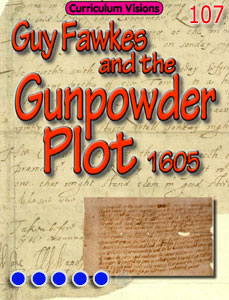The Gunpowder Plot was all about killing King James I and replacing him with his Catholic-leaning daughter, Princess Elizabeth.
After that, there was to be a general revolt.
The people who took part in the Gunpowder Plot were Robert Catesby, John Wright, Thomas Wintour, Thomas Percy, Guy Fawkes, Robert Keyes, Thomas Bates, Robert Wintour, Christopher Wright, John Grant, Sir Ambrose Rookwood, Sir Everard Digby and Francis Tresham.
These 17th century bombers laid their plans just as modern bombers do today. For them, the place was to be the Houses of Parliament, and the date was to be November 5th, at the time the king would be speaking to Parliament. The ringleader was Robert Catesby, although, of course, we best know the name of one of the other plotters – Guy Fawkes.
Guy Fawkes was important because he had ten years of military experience. That is why he was put in charge of the explosives.
The Palace of Westminster, also known as the Houses of Parliament, did not look as it does today, but had grown up over the centuries until it was a warren of buildings that contained chapels, part of the former royal palace, Parliament and the law courts.
Many of these buildings had basements or ground floor rooms (known then as undercrofts) where there were kitchens and storage rooms. Most of the official business was conducted on the first floors of the buildings. It was in one of the unused undercrofts that the plotters placed their gunpowder.
The plotters had rented rooms across the river from Parliament, and rowed their barrels of gunpowder over the river in the dead of night, hiding it behind stacks of firewood.
However, the government got wind of the plot and arrested Guy Fawkes in the basement, and soon had the others in captivity, as well.




